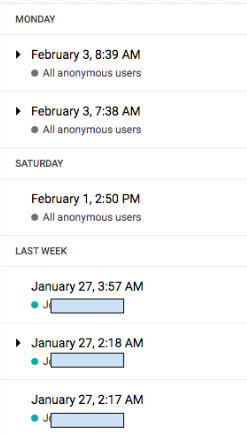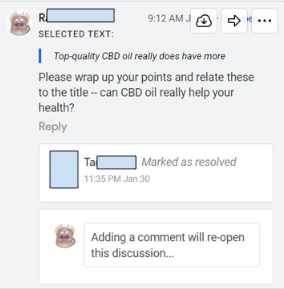Outsourced content, I’m sure we’ve all experienced it once in our working life. You hire a writer who has an outstanding sample piece, a resume to back it up, and whose keenness is bordering on being a bit too enthusiastic.
However, because you’re looking for the best of the best, you give them a go—only to find out they’ve outsourced the content to another writer who isn’t as good as the original samples, and now you’re behind on your content deadlines.
The problem is, not everyone knows the signs to watch out for when it comes to the content being outsourced. So after recently experiencing this, and with some help from our senior editors, we’re able to provide detailed information on how you can spot a con quickly and kick their asses to the curb.
So without further dragging this out any longer, let’s get down to the nitty-gritty.

#1. Changes In Formatting
So this is the number 1 sign your writer is outsourcing their work.
Hands down.
Every writer has a unique style, no matter their writing level. This was the first red flag that started to raise our suspicions. To spot notable changes in formatting look for these key clues:
Subheadings
The way the subheadings are shouldn’t change from article to article too much. Let’s take these examples below of the “same” person doing a couple of different articles:
Article #1: As you can see with this example, the subheading shows the words are in lower case, but with capitals on each one.

Article #2: In this example the article subheading is all in capitals.

Article #3: This one shows a sentence/question form for the subheadings.

While some writers may try to mix it up a little with their content creation, generally, their style of writing tends to fall in line with consistency to a certain degree. And as you can see above, it’s not overly consistent.
Let’s move on to…
#2. Writing Ability
To be a professional writer, let’s face it—you have to have some degree of skill. Hands up if you agree!

When you receive multiple articles from one person, and you see any of the following signs, then you can raise that red flag just a little bit higher.
- Does one piece of content seem to read a lot better than others?
- Does one seem to have certain spelling mistakes where the other one doesn’t?
- Does one have apostrophes used for words like can’t, doesn’t—and the other one does not? ← See what I did there?
- Does one pass Copyscape.com but another one doesn’t (and I mean large clashes where they’ve basically copied and pasted the info)?
- Does the article reflect poor overall English skills—grammar, spelling, sentence, structure, etc., which is seen more in one article than the other?
Writing ability doesn’t really change too much. Even with a topic that’s unfamiliar to the writer, you’ll always see some consistent key signs throughout the article. You just have to keep watch and train your eye to see them.
Let’s move on to…
#3. Tone and Voice Conveyed
Well, you can either say it in a nice way, or come off like a complete @%#! when it comes to the tone of your article. For the writer we used, we found that the tone of voice in how the articles were written seemed to change from article to article. I’ll give 2 written examples below of a sentence that’s written in different ways but mean the same:
- CBD can be a great alternative medicine as long as it’s used correctly as per the recommended dosage.
- Use CBD correctly and you won’t have any issues with this alternative medicine.
Do you see the difference in how the message was conveyed? One was conveyed in an informational way, while the other one was more direct and a little condescending.
Generally, the tone of voice throughout the articles will be similar if it’s the same writer. It’s something that’s not really taught but comes naturally from a writer and their ability. So that’s something to keep in mind.
Next!
#4. Large Formatting Issues
Ah formatting, nothing is worse than when you see an article not formatted correctly. It really does sting the eyes, doesn’t it?
It’s even more concerning when the same writer has a difference in formatting throughout different articles. Here’s some formatting changes we experienced with a particular writer:
Problem #1: Large spacing between the subheadings and the paragraphs when others show the space is closer.
Sample 1:

Sample 2: When Spacing Is Normal

Problem #2: Bullet points not used when others show proper understanding of how to use them.
Sample 1:

Sample 2: When Bullets Are Used Correctly

Need I say more?
Yes!
#5. Anonymous Writer Changes
This one is definitely a clear sign. Take a look at the screenshot to see exactly what I’m talking about.

While we do respect the privacy of the writer in question—we’re not that mean—this example here gives you some indication that the writer may not be the only one working on the article. There’s not much else that can be said here.
The only thing I recommend is to make sure any writers you hire use Google Docs and share them with you so you can see who is making the edits. You can generally see the above screenshot when you click the speech bubble at the top of the document, next to the share button.
![]()
And finally…
#6. Different Writers Resolving Changes
Last but not least, drum roll please…

When another writer actually resolves comments that you may leave.

So in this example above you can see our Editor—let’s call her Mrs. R—is editing one from a writer by the name of Mr. J, whom we hired. Then when it comes to resolving comments left by our editor, someone by the name of Ms. T has resolved them.

Yes, you got that right.
Enough said.
Overall
So there you have it—a simple writer outsourcing their work to other writers in order to make money off the top. At the end of the day, this can only lead to one thing…

So if you’re someone looking to cheat your boss by doing this above, don’t do it—it’s just not worth it.
For those who are employing someone to write for them, I hope this information will give you insight and some comfort that you can spot these signs and not get caught off guard. Luckily, we found this one out within 2 weeks.
Good luck with your content hiring everyone.
That’s it from me!

